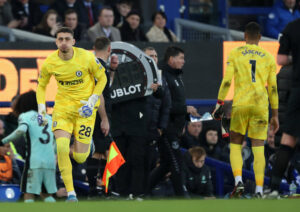VAR. It’s become a dirty word in the footballing lexicon, generally spat out by its detractors in a virulent manner.
In theory, it’s a great idea. It offers a safety net for referees and allows them time to make a more accurate decision. In practice, not so much.
The Video Assistant Referee has been extremely divisive ever since its inception in 2012 in The Netherlands. It’s inconsistent, referees still don’t seem to be able to use it correctly and it slows games down to a crawl. If it is to remain in the Premier League, changes have to be made.
VAR has been circulating for almost a decade now, but it first rose to prominence during the 2018 World Cup. At this tournament, it was generally well-received, give or take a couple of howlers. It appeared to be a step in the right direction and a useful tool for refereeing.
Since then, let’s just say that positive opinions on the system have regressed. However, it can be improved to a state of viability – here’s how.
The Problems With VAR in the Premier League and How to Improve It
Improve How Long VAR Takes
When VAR is called upon for a contentious decision, the pace of the game is drastically slowed. The referee is summoned to the VAR stand, takes his time reviewing the footage, then returns to the field to give the verdict. This not only kills the engagement of both the fans in the ground and the TV audience, but it can also affect the momentum of a game.
If a team is pushing for a goal before a VAR review, it gives the opposition valuable seconds to regroup. This gives the opposing team an inorganic advantage in the process.
Moreover, it’s also both incredibly frustrating and dull to witness. Not a desirable combination when you’re watching something that’s marketed as entertainment.
A simple way to ameliorate this would be to remove the VAR stand. Instead, give referees tablets to carry around, so they can view incidents in an instant. While the referee is viewing the passage of play in question, players must be required to stand well away.
This may be unnecessarily expensive, and somewhat ridiculous, but surely the FA can afford to buy a tablet for each club in the Premier League. If not, then the clubs themselves definitely can. It’d be a small price to pay for a faster-paced game while retaining VAR’s precision.
Confusion Surrounding Offsides
This season especially, it seems referees have had to completely relearn the offside rule. VAR has given us an inhuman level of accuracy in regard to offsides. However, this is both a blessing and a curse.
On one hand, it’s virtually impossible to miss an offside now. On the other – where do you draw the line with this?
Players are currently being flagged offside even if a mere atom of their body strays past the last man. It’s ridiculous.
Should it count as offside if a player’s arm is offside? They can’t legally score with this part of their anatomy, so what’s the issue if a flailing arm strays offside?
If possible, this needs to be changed. If a part of a player’s body that can be legally scored with is offside, fair enough. To give offside for a fingernail seems pedantic.
Alternatively, some leeway could be given to the attackers. If a player is offside by a fraction, where only a computer could tell the difference, it should count as onside. This may lead to inconsistencies, but it’s better than the farcical procedure currently in place, where perfectly legal goals are being ruled out.
Referees are Still Getting it Wrong
VAR was put in place to give referees a safety net to improve their decision making. In the heat of the moment, it’s very easy to lose composure and make a rash choice.
So then, despite this, why are Premier League referees still doing a substandard job? At what point do we stop blaming the technology and start pointing the finger at the people using it?
For example, look at the Aston Villa v Sheffield United game from the 2019/20 season. While technically the fault of goal-line technology, Michael Oliver had every chance to take another look and correct himself. He did not.
To take it a step further, why wasn’t he alerted by the VAR staff through his headset? If he was, did he choose to ignore them? It’s both baffling and maddening.
Giving referees microphone headsets to explain their decisions would be great for transparency. However, this will not weed out mistakes on its own. Forcing referees to explain bad calls doesn’t eliminate the bad call itself.
VAR was introduced to improve the standard of refereeing, but this has not occurred. Slack mistakes are still being made, only now we have to wait for them to be confirmed.
Despite their new safety net, referees in England are still making poor errors that are affecting games. Perhaps it’s time their performances were judged more harshly by the FA – if not, a complete overhaul of staff could be in order. If they’re not good enough, they’re not good enough.
Main Photo






